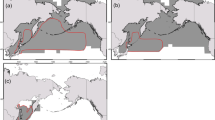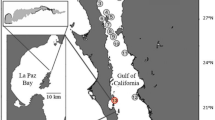Abstract
Over the last few decades wild population of Chitala chitala (HamiltonBuchanan) has been declined more than 50% due to various reasons and is presently listed under endangered (EN) category due to reduced abundance. In the present communication wild C. chitala were collected from natural habitats and induced to spawn under captivity during July 2002 by injecting three different doses of synthetic hormone Ovaprim. Intramuscular injections were administered to fishes using three different doses (1.5, 1.0 and 0.5 ml/kg body weight). Artificial breeding pool was prepared for each set by encircling area (20 × 5 m) with mosquito net, where wooden country boat (8 × 4 × 2.5 feet with surface area 48.5 sq. feet) was placed inside the breeding pool. Distinct spawning behavior was noticed in the experimental sets with different hormonal dose whereas no spawning activity was noticed in control set. The fertilization rate varied from 48.8680.2% and total numbers of spawned eggs in two sets of experiments were estimated to be 81,034. The average number of eggs deposited 15 ± 2.1/square inches. The fertilized eggs were large in size (4.5 ± 0.05 mm), adhesive and attached to the hard substratum. The eggs hatch out between 168192 h after fertilization and about 33,639 hatchlings were produced. Newly hatched larvae measured 10.23 ± 0.03 mm and 0.031± 0.008 gm in weight and the mean diameter of yolk sac was 4.1 ± 0.08 mm. The yolk sac remains attached up to a week. The percentage survival of hatchlings varied from 42.2 to 65.60. Statistical analysis was worked out to determine the relation between the hormone dosage with different breeding parameters like latency period, fertilization rate, egg output, hatching rate and hatchling production.
Similar content being viewed by others
References
Ayyappan S., Raizada S. and Reddy A.K. (2001). Captive breeding and culture of new species of aquaculture. In: Ponniah K., Lal A.G. and Baseer V.S. (eds), Captive Breeding for Aquaculture and Fish Germplasm Conservation Publ, 3. NBFGR-NATP, Lucknow
Conservation Assessment and Management Plan CAMP Report (1998). Freshwater Fishes of IndiaNational Bureau Fish Genetic Resources. Lucknow and Zoo Outreach Organization, Coimbatore, 327
Anonymous (2002). National Agricultural Technology Project (NATP) Report (2002-2003). National Bureau of Fish Genetic Resources, Lucknow, India, 3 pp.
Bagenal T.B. and Braun E. (1968). Eggs and early life history. In: (eds) Methods for Assessment of Fish Production in Freshwater, pp 159–181. Blackwell Scientific, Oxford IBP Handbook No. 3
Chonder S.L. (1999). Biology of Finfish and Shell Fish. SCSC Publishers, India, 1–514
Habibi H.R., Marchant T.A., Nahorniak C.S., Vanderloo H., Peter R.E., Rivier J.E. and Vale W.W. (1989). Functional relationship between receptopuir binding and biological activity for analogous of mammalian and salmon gonadotropin releasing hormone in the pituitary of Goldfish (Carrassius auratus). Biol. Rep. 40: 1152–1161
Haniffa M.A., Merlin Rose T. and Shaik M.J. (1996). Induced of ovulation in Channa striatus by salmon gonadotropin releasing hormone analogue (sGNRH). Fish. Chimes 16: 23–24
Haniffa M.A., Marline T.R. and Shaik M.J. (2000). Induced spawning of the stripped murrel Channa striarus using putitory extracts, HCG, LHRHa and ovaprim. Acta. Icht. Piscat. 30: 53–60
Hossain Q.Z. (1999). Some observations on breeding and fry rearing of Chital (Notopterus chitala Ham.) in Bangladesh. Fish. Chimes 19(7): 13–16
Mobarek A.B.D. (1980). Studies on certain aspects of biology and reproduction of genus Notopterus. Calcutta University, Calcutta
Nandeesha M.C., Das S.K., Nathaniel D.E., Varghese T.J. and Shetty H.P.C. (1990). Breeding of Carp with Ovaprim Standardization of Dosage and Nation wide Demonstration (Abstract). World Aquaculture Society, Halifax, Canada, 81
Singh S.B., Dey R.K., Reddy P.V.G.K. and Misra B.K. (1980). Some observations on breeding, growth and fecundity of Notopterus chitala. J. Inla. Fish. Soc. 2: 13–17
Singh V.D. (1996). Remembering Chitala. Fish. Chimes 16(9): 9
Singh D.V., Ram R.N. and Singh I.J. (2002). Evaluation of dose of Ovaprim for inducing ovarian maturation and ovulatory response in the catfishHeteropneustes fossilis. Indian J. Fish. 49(1): 1–12
Southwell T. and Prashad B. (1918). On hilsa investigations in Bengal, Bihar and Orissa. Bull. Dept. Fish. Ben 11: 1–12
Ponniah A.G. and Sarkar U.K. (2000). Fish Biodiversity of North-East India., Publ. NBFGR. NATP, Lucknow 2: 11–30
Author information
Authors and Affiliations
Corresponding author
Rights and permissions
About this article
Cite this article
Sarkar, U.K., Deepak, P.K., Negi, R.S. et al. Captive breeding of endangered fish Chitala chitala (Hamilton-Buchanan) for species conservation and sustainable utilization. Biodivers Conserv 15, 3579–3589 (2006). https://doi.org/10.1007/s10531-004-2935-6
Received:
Accepted:
Published:
Issue Date:
DOI: https://doi.org/10.1007/s10531-004-2935-6




